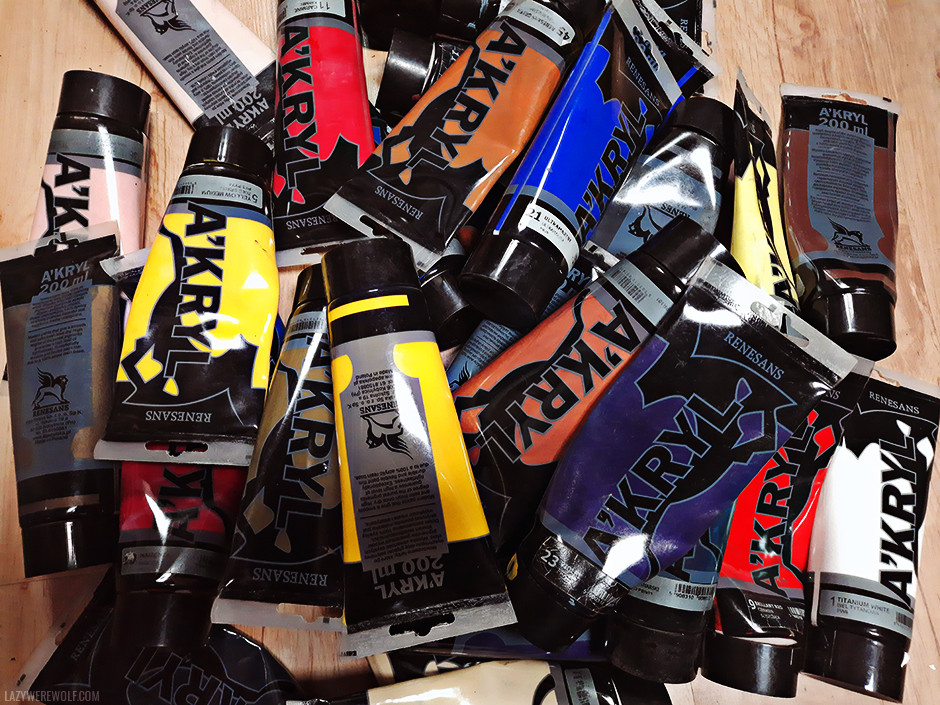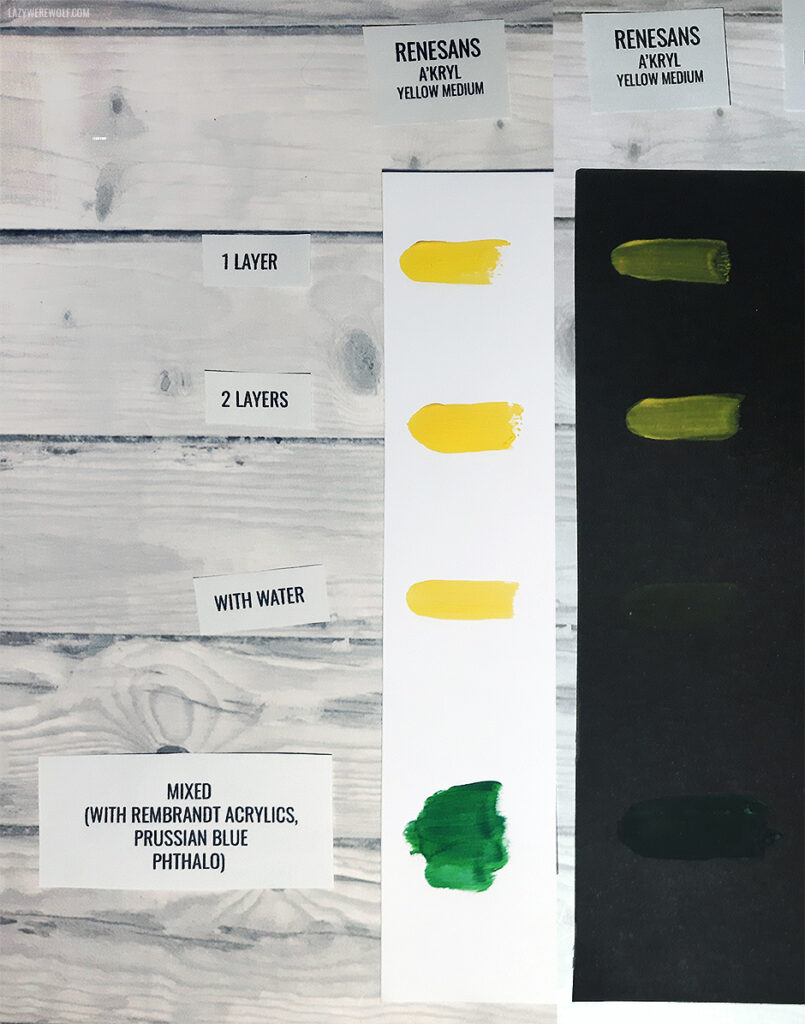Revisiting my first paints – a horror story
Hello everyone, I hope you all are doing well!
I was recently invited to participate in a joint gallery with my past painting group! How cool is that?! I’m very excited about it because I haven’t participated in gallery shows for a long time now! It’s a big honour for me to be invited just like that AND by my past painting instructor! ❤️
To have a decent amount of artworks to hang at the exhibition, I’ve decided to finish two of my old, unfinished paintings that were staring at me every time I passed them (causing remorse). The thing is, the older painting I’ve started in 2019 before I switched to my current, mid-range paints that I actually really like (now I’m using Royal Talens Rembrandt acrylics, back then it was Renesans A’kryl). So, in order to finish the painting properly and make it look consistent, I had to use my old paints. Fortunately, I had some leftovers from the good old times…

I used to use the A’kryl paints in the past because they were good and cheap (16,85 PLN for 200 ml / 3,96 USD/200ml). I remember I actually liked them and I’ve only switched to different paints because of a Royal Talens Rembrandt competition in late 2019 where one of the rules was to use a Royal Talens Rembrandt art supply. So I bought the Rembrandt acrylics, tried them, loved them, stuck to them ever since.
I don’t remember very well my first impressions of the Rembrandt paints, but what I do remember is that they were thicker, more opaque and weren’t drying as fast as A’kryls. Now, after several years of using the Rembrandts, I was very curious about how would my old paints perform compared to them and how would I be able to apply everything I’ve learned throughout the years.
The painting I was about to start finishing (yes, start finishing!) was the poppies one, you might remember it if you follow me on Facebook… for at least 3 years 🙂 I had to dust the painting a bit (it did wait for its time for quite long!) before I could continue working on it. Even though most of it I’ve already had painted, there were still some areas that needed some polishing, so I squeezed the paints on my palette and…
The first thing I noticed was that the A’kryls weren’t as liquidy as I remembered them to be. Maybe I still was under the impression of the Rembrandts being much thicker than them, so the A’kryls, by comparison, “had” to be liquidy, but they aren’t really – they’re also quite thick. But, maybe they got thicker from evaporation while they were waiting for better times on my shelf for several years. Either way – I was surprised because I remembered them differently.
When I started fixing the painting with the A’kryls, I instantly thought, that they’re actually not that bad. Sure they were matte (I used to like it but now I prefer satin finish in paints), but they were not bad at all! I even started wondering if I should perhaps keep using them for my personal projects since they are performing surprisingly good, they’re cheap and the matte finish can be fixed with satin or glossy varnish.
But then when the paints started drying and I kept working on the painting – I realized many things.
First of all, the paints are VERY transparent. You need several layers of any colour to fully cover the surface. Normally you’d expect much more opaqueness from acrylic paints. The yellow A’kryls in particular are way too transparent. They are thick, yes, but when you put them on canvas there is so little colour in them as if they were diluted with water. You can see on the image below, on the black paper’s side, how bad is their coverage. It’s not visible that well on the white paper, for some reason.

The next thing is that these paints dry extremely fast! Fortunately, there are tricks to mitigate it, so it was still possible to work with the paints, but even though I did know they dried faster than Rembrandts, I didn’t expect such a short drying time. Of course, acrylics generally dry pretty fast, it’s one of their features, but the better the paints, the slower they dry. That’s pretty telling about the quality of A’kryls.
The biggest problem for me was that even though the colours seemed vivid straight from the tube, when they dried on the canvas – they got darker and duller. It was very hard to get bright, juicy colours from these paints. The worst part is that when mixing the colours, you don’t know what will they turn out like when dry, so it’s a huge problem to match the already existing colours on the canvas. When you add to the equation the extremely short drying time – you get an artist’s nightmare.
Another important thing to know is that when the A’kryl paints dry, they feel and look almost chalky and weirdly rubbery. The chalkiness might be there to make the paints matte, or maybe the paints are matte because of their chalkiness? Either way, that chalkiness reminded me of cheap watercolours for children. It was very strange to observe in acrylics.
The matte finish in the paints is fine, I used to like it, but nowadays I’m not a fan of it anymore. I feel like satin or glossy paints have some richness to them and even if the colours are muted, with some shine they somehow look deeper. But the finish is a matter of preference.
Overall the paints do their basic job, which is tinting a surface, but that is a very low set bar and if you don’t want to struggle with your paints you should set it a bit higher. Painting with A’kryls is a struggle, matching colours is difficult because the paints get darker when they dry. The painting process is a generally unpleasant experience with A’kryls. I don’t want to use these paints anymore, unless I get stuck on a desert island.
I used to like A’kryls as a beginner and they do have some good opinions online, but I also gave them a good one back in the days, when I didn’t know how acrylics should behave. I’d like to be able to recommend these paints at least to beginners, but I honestly can’t do it with a clear conscience, that would be simply cruel of me. Instead, I can recommend either Liquitex Basics or Maimeri Acrilico. Both are good, don’t change colours, have a delicate satin finish and are perfect for beginners. They are more expensive than Renesans A’kryl but it’s not worth it to spend money on something as bad as A’kryls.
But if you do want chalky, matte acrylics and you don’t mind the colours getting darker and desaturated when the paints dry, you may want to give A’kryls a go. And even if those features aren’t what you’re looking for, it’s still possible to paint with them and get good results, you only need a lot of patience. Below you can see some of the paintings in which I actually used the A’kryl paints.



So, what’s my final verdict for Renesans A’kryl? I don’t want to give these paints a score. You can paint beautiful artworks with them but the process is so frustrating and time-consuming that I don’t think they’re worth it. Not for me anyway. I did NOT like them at all after using better paints for a long time and I don’t want to come back to using A’kryls. But if they are paints for you – you have to decide on your own!


